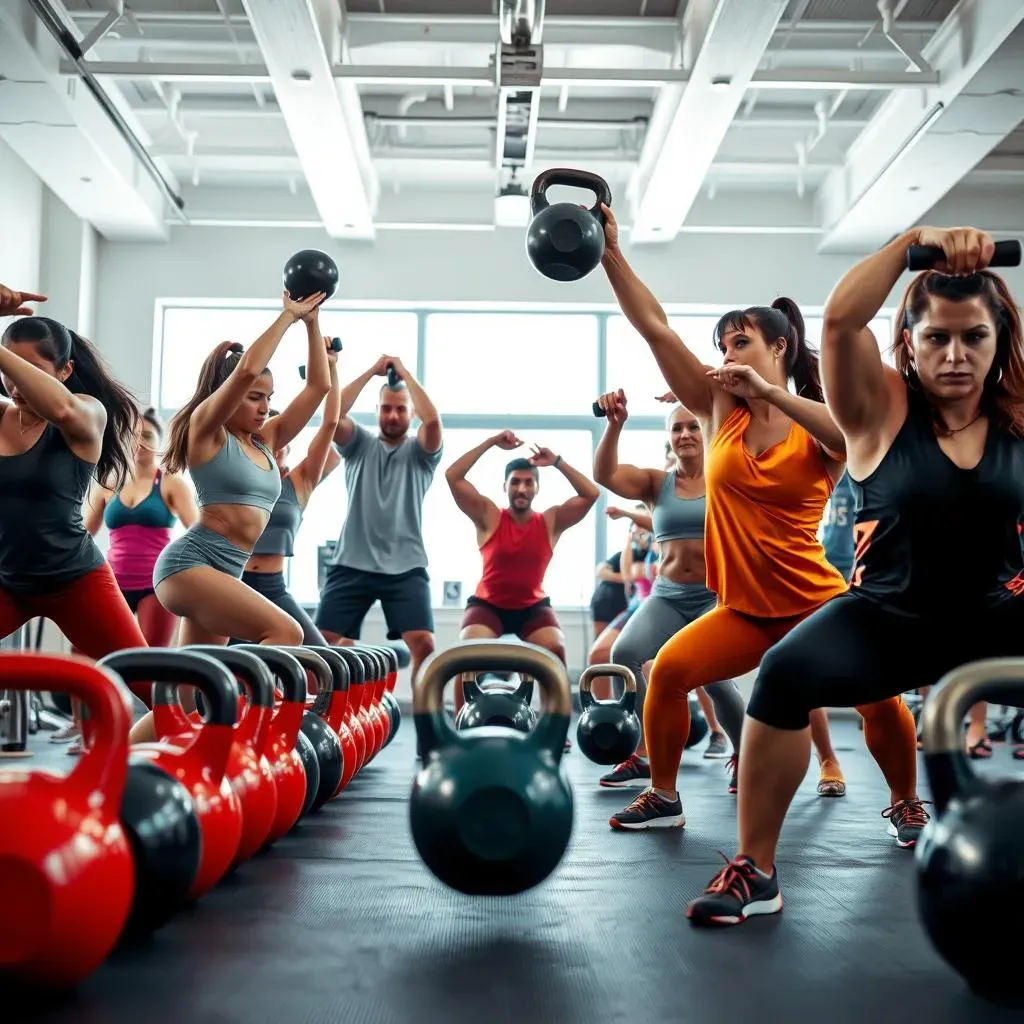Table of Contents
Ready to torch calories, build serious strength, and unlock explosive power? A kettlebell workout full body is your secret weapon. Forget endless hours on the treadmill or isolating muscles one by one. Kettlebells deliver a dynamic, efficient workout that hits everything, from your core to your quads, all while boosting your cardio. This isn't just about lifting weight; it's about moving weight, engaging your entire body with every swing, squat, and press. We'll break down why kettlebells are so effective for a full-body transformation, covering essential exercises like swings, cleans, and presses. You'll learn how to craft your own killer routine, nail proper form to prevent injury, and progressively challenge yourself for continuous gains. Whether you're a seasoned athlete or just starting your fitness journey, get ready to discover the incredible benefits of the kettlebell workout full body. Let's swing into action and unleash your inner beast!
Why a Full Body Kettlebell Workout Rocks

Why a Full Body Kettlebell Workout Rocks
let's get real about why a full body kettlebell workout rocks. It's not just some fitness fad; it's a powerhouse for transforming your body and boosting your athleticism. Forget those boring, repetitive gym routines that isolate one muscle at a time. Kettlebells force your entire body to work as a unit, engaging your core, improving your balance, and building functional strength that translates directly into real-life activities. Think about it: when you swing a kettlebell, you're not just working your arms and shoulders; you're firing up your glutes, hamstrings, and core to stabilize and control the movement. It's like a symphony of muscles working together in perfect harmony. That's the beauty of kettlebells – they turn every exercise into a full-body challenge.
Essential Kettlebell Exercises for a Full Body Blast

Essential Kettlebell Exercises for a Full Body Blast
The King: Kettlebell Swing
If there's one exercise that defines kettlebell training, it's the swing. It's the foundation upon which so many other movements are built. The kettlebell swing isn't just about your arms lifting a weight. It's a powerful hip hinge movement that engages your glutes, hamstrings, core, and back. When done correctly, you'll feel the burn in all the right places. This exercise builds explosive power, improves cardiovascular fitness, and strengthens your posterior chain. Think of it as the ultimate bang-for-your-buck exercise. The swing is a must-have in any kettlebell workout full body routine.
The Dynamic Duo: Clean and Press
Ready to take things up a notch? The clean and press combines two movements into one fluid motion. First, you'll clean the kettlebell, bringing it from the ground to a racked position at your shoulder. Then, you'll press it overhead, engaging your shoulders, triceps, and core. The clean and press is a fantastic exercise for building upper body strength and power, while also improving your coordination and stability. It's a challenging but rewarding exercise that will leave you feeling like a total badass. Incorporating clean and press in your kettlebell workout full body will help you achieve your fitness goals faster.
Exercise | Muscles Targeted | Benefits |
|---|---|---|
Kettlebell Swing | Glutes, Hamstrings, Core, Back | Explosive power, Cardio, Posterior chain strength |
Clean and Press | Shoulders, Triceps, Core | Upper body strength, Coordination, Stability |
The Ground Control: Renegade Row
Now, let's get down on the ground for the renegade row. This exercise is a killer for your core and upper body. Start in a plank position with each hand gripping a kettlebell. Then, while maintaining a stable plank, row one kettlebell up towards your chest, engaging your back and biceps. Alternate sides, keeping your hips square to the ground. The renegade row challenges your core stability, strengthens your back, and improves your anti-rotation strength. Plus, it looks pretty darn cool when you nail it. Don't underestimate the power of the renegade row; it's a game-changer for any kettlebell workout full body. Make sure to add this exercise to your routine for maximum results.
Crafting Your Kettlebell Workout Full Body Routine

Crafting Your Kettlebell Workout Full Body Routine
Set Your Goals
Before you even pick up a kettlebell, get clear on what you want to achieve. Are you aiming for fat loss, muscle gain, improved endurance, or a combination of all three? Your goals will dictate the exercises you choose, the number of reps and sets you perform, and the rest periods you take. For example, if your primary goal is fat loss, you'll want to focus on higher rep ranges and shorter rest periods to keep your heart rate elevated. If you're looking to build strength, you'll want to use heavier weights and lower rep ranges. Be specific and realistic with your goals, and write them down to stay motivated. Remember, a well-defined goal is half the battle when crafting your kettlebell workout full body routine.
Once you've defined your goals, assess your current fitness level. Have you been consistently working out, or are you just starting? Be honest with yourself, and don't try to do too much too soon. Start with lighter weights and fewer reps, and gradually increase the intensity as you get stronger. It's always better to start slow and progress safely than to jump in headfirst and risk injury. Listen to your body, and don't be afraid to modify exercises or take rest days when needed. This is your journey, so make sure you enjoy the process of crafting your kettlebell workout full body routine.
Structuring Your Workout
Now that you've set your goals and assessed your fitness level, it's time to structure your workout. A typical kettlebell workout full body routine should include a warm-up, a strength training portion, a cardio portion, and a cool-down. The warm-up should consist of dynamic stretches and light cardio to prepare your muscles for the workout ahead. The strength training portion should focus on compound exercises that work multiple muscle groups simultaneously, such as swings, cleans, presses, and squats. The cardio portion can include exercises like kettlebell snatches or burpees to elevate your heart rate and burn calories. The cool-down should consist of static stretches to improve flexibility and reduce muscle soreness.
Consider using supersets to maximize your time and intensity. Supersets involve performing two exercises back-to-back with minimal rest in between. For example, you could pair kettlebell swings with push-ups or goblet squats with rows. Supersets not only save time but also increase the metabolic demand of your workout, leading to greater calorie burn and muscle growth. Experiment with different superset combinations to find what works best for you and keeps your workout engaging. Remember, variety is the spice of life, especially when crafting your kettlebell workout full body routine. Don't be afraid to switch things up to prevent boredom and plateaus.
Workout Component | Example Exercises | Benefits |
|---|---|---|
Warm-up | Dynamic stretches, Light cardio | Prepares muscles, Increases blood flow |
Strength Training | Swings, Cleans, Presses, Squats | Builds muscle, Increases strength |
Cardio | Snatches, Burpees | Burns calories, Improves cardiovascular fitness |
Cool-down | Static stretches | Improves flexibility, Reduces muscle soreness |
Perfecting Your Form: Kettlebell Workout Technique

Perfecting Your Form: Kettlebell Workout Technique
Alright, let's talk form. Because honestly, with kettlebells, it's everything. You can have all the enthusiasm in the world, but if your technique is off, you're just asking for trouble – and by trouble, I mean injuries that'll sideline you faster than you can say "herniated disc." Perfecting your form: kettlebell workout technique isn't about being a perfectionist; it's about being smart, safe, and effective. Think of it like this: every rep with good form is an investment in your long-term fitness, while every rep with bad form is a withdrawal from your injury-free account. So, let's break down the essentials to keep you swinging, cleaning, and pressing your way to a stronger, healthier you. We will cover the common mistakes, bracing and breathing, and start with lighter weight.
Common Mistakes to Avoid
First things first, let's address the elephant in the room: common mistakes. These are the pitfalls that even experienced kettlebell enthusiasts sometimes fall into. One of the biggest culprits is rounding the back during swings and deadlifts. This puts undue stress on your spine and can lead to serious back pain. Always maintain a neutral spine, hinging at your hips and keeping your core engaged. Another common mistake is using your arms too much during swings. Remember, the swing is a hip-hinge movement, not an arm raise. Let your hips generate the power, and your arms will simply guide the kettlebell. Lastly, don't forget about your breathing. Holding your breath can increase your blood pressure and make you feel lightheaded. Exhale forcefully during the most challenging part of each exercise.
- Rounding the back: Maintain a neutral spine.
- Using arms too much: Focus on hip hinge for power.
- Holding your breath: Exhale during exertion.
Bracing and Breathing
Now, let's dive deeper into the art of bracing and breathing. Bracing your core is like putting on an internal weightlifting belt. Before each rep, take a deep breath into your belly, and then tighten your abdominal muscles as if you're about to be punched in the gut. This creates a stable base of support for your spine and helps you generate more power. As for breathing, the general rule is to exhale during the concentric (lifting) phase of the exercise and inhale during the eccentric (lowering) phase. For example, during a swing, you'll exhale as you drive your hips forward and inhale as you let the kettlebell swing back down. Experiment with different breathing patterns to find what feels most natural and effective for you.
Proper bracing also protects your spine. It is like creating a solid foundation for movement. When you brace correctly, you're not just engaging your abs; you're activating all the muscles in your core, including your obliques, transverse abdominis, and erector spinae. This creates a rigid cylinder around your spine, preventing it from flexing, extending, or rotating excessively. Think of it as building a fortress around your spine, protecting it from injury. Practice bracing regularly, even when you're not working out, to improve your core stability and prevent back pain. Perfecting your form: kettlebell workout technique requires constant attention to these details, but the payoff is well worth the effort.
Start with Lighter Weight
I can't stress this enough: start with lighter weight. Your ego might be telling you to grab the heaviest kettlebell in the gym, but trust me, that's a recipe for disaster. It's far better to master the movement with a lighter weight and gradually increase the load as you get stronger. This allows you to focus on your form, build a solid foundation of strength, and minimize your risk of injury. Remember, there's no shame in starting small. Everyone starts somewhere, and even the most seasoned kettlebell athletes had to learn the basics. So, swallow your pride, grab a lighter kettlebell, and focus on perfecting your form: kettlebell workout technique. Your body will thank you for it.
Progressing Your Full Body Kettlebell Workout

Progressing Your Full Body Kettlebell Workout
Increasing the Weight
so you've nailed the form, you're feeling stronger, and those kettlebells are starting to feel a little too light. It's time to talk about increasing the weight. But hold on, cowboy! This isn't about ego lifting. It's about making gradual, controlled progress. The key is to increase the weight only when you can maintain perfect form throughout the entire set. If your form starts to break down, it's a sign that you're not ready for the heavier weight. Start by increasing the weight by a small increment, such as 2-4 kg, and see how it feels. If it feels too heavy, don't be afraid to go back down to the lighter weight. Remember, consistency and proper form are more important than lifting the heaviest weight possible. Progressing your full body kettlebell workout requires patience and discipline. Don't rush the process, and trust that you will get stronger over time.
Also, don't be afraid to mix and match weights. You might be able to swing a heavier kettlebell than you can clean and press. That's perfectly fine. Use the appropriate weight for each exercise, and gradually increase the weight as you get stronger. Keep a workout journal to track your progress. Write down the exercises you perform, the weight you use, and the number of reps and sets you complete. This will help you monitor your progress and identify areas where you need to focus your efforts. It's also a great way to stay motivated and see how far you've come. Progressing your full body kettlebell workout is a journey, not a destination. Enjoy the process, and celebrate your achievements along the way.
Adding Volume and Intensity
Ready to crank things up a notch? Once you've mastered the basic movements and you're comfortable with a certain weight, it's time to start adding volume and intensity to your workouts. Volume refers to the total amount of work you do, while intensity refers to the level of effort you exert. There are several ways to increase volume, such as adding more reps, sets, or exercises. For example, if you're currently doing 3 sets of 10 swings, you could increase that to 4 sets of 12 swings. You can also increase the intensity by shortening your rest periods, using more challenging variations of exercises, or adding resistance bands.
Consider incorporating techniques like drop sets or supersets to further increase the intensity of your workouts. Drop sets involve performing an exercise to failure, then immediately reducing the weight and continuing to perform reps until failure again. Supersets involve performing two exercises back-to-back with minimal rest in between. These techniques can help you push your muscles to their limits and stimulate greater muscle growth and strength gains. However, be careful not to overdo it. Start with one or two of these techniques per workout and gradually increase the frequency as you get more conditioned. Progressing your full body kettlebell workout requires a delicate balance between pushing yourself and avoiding overtraining. Listen to your body, and don't be afraid to take rest days when needed.
Progressive Overload Method | Description | Example |
|---|---|---|
Increase Weight | Gradually lift heavier kettlebells. | Moving from a 16kg to a 20kg kettlebell for swings. |
Increase Reps | Perform more repetitions with the same weight. | Going from 10 to 15 reps of kettlebell squats. |
Increase Sets | Add more sets of the same exercise. | Performing 4 sets instead of 3 sets of clean and press. |
Decrease Rest | Reduce the rest time between sets. | Cutting rest from 90 seconds to 60 seconds. |
Exploring Advanced Exercises
Feeling like a kettlebell ninja? Then it's time to explore some advanced exercises that will challenge your strength, coordination, and athleticism. Exercises like the kettlebell snatch, Turkish get-up, and windmill require a high degree of skill and control, so it's important to master the basic movements before attempting these advanced variations. The kettlebell snatch is a dynamic exercise that involves lifting the kettlebell from the ground to an overhead position in one fluid motion. It's a fantastic exercise for building explosive power and improving cardiovascular fitness. The Turkish get-up is a complex, multi-joint exercise that involves transitioning from a lying position to a standing position while holding a kettlebell overhead. It's a great exercise for improving core stability, shoulder mobility, and overall body control.
Before attempting these advanced exercises, seek guidance from a qualified kettlebell instructor. They can teach you the proper technique and help you progress safely. Start with lighter weights and gradually increase the load as you get more comfortable with the movements. Don't be afraid to break down the exercises into smaller, more manageable steps. Focus on mastering each step before moving on to the next. Remember, progressing your full body kettlebell workout is about continuous learning and improvement. Embrace the challenge, stay patient, and celebrate your accomplishments along the way.
Full Body Kettlebell Workout: Your Path to Strength and Power
So, you've journeyed through the world of kettlebell training, explored essential exercises, and learned how to build your own full-body routine. The power is now in your hands to sculpt your body, boost your endurance, and unlock a new level of fitness. Remember, consistency and proper form are key. Start light, master the movements, and progressively challenge yourself. A kettlebell workout full body isn't just a workout; it's an investment in your health, strength, and overall well-being. Now go out there and swing your way to a stronger, fitter you!